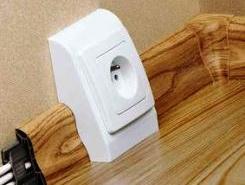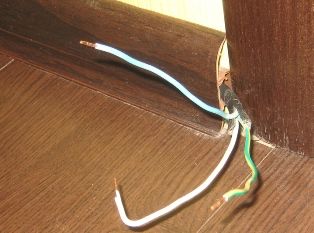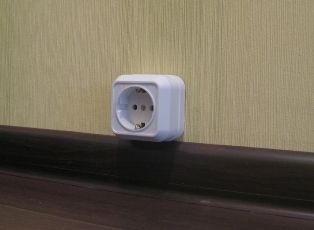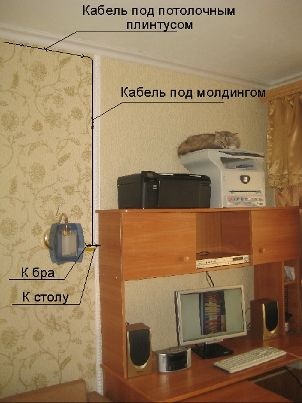Categories: Featured Articles » Electrician at home
Number of views: 52358
Comments on the article: 5
How to replace the wiring after the repair
 Often there is a need for partial or complete wiring replacement after already completed repairs. Wallpaper is pasted, and there is no way to lay cables under the plaster. Floor and ceiling skirting boards come to the rescue, having cavities in which you can freely place cable.
Often there is a need for partial or complete wiring replacement after already completed repairs. Wallpaper is pasted, and there is no way to lay cables under the plaster. Floor and ceiling skirting boards come to the rescue, having cavities in which you can freely place cable.
In fig. 1 shows a floor plinth specifically designed for laying a cable therein. This skirting board has a detachable cover that allows you to lay the cable in it without removing the skirting board.
In the simplest case, sockets can be located directly above the baseboard, as shown in Fig. 2. Such a need often arises, for example, after moving furniture in an apartment, when the furniture closes existing outlets. Special cavities for cables can also be in casings for doors and windows.
Ample opportunities for concealed cable routing are provided by ceiling skirting boards, which are now widely used. In fig. 3 shows various ceiling skirting boards made of lightweight polyurethane. If the need for laying new cables arose before gluing the ceiling skirting boards, then there are no problems laying additional cables.
If the skirting boards are glued, then with the large sizes of the skirting boards, the cables can be carefully “inserted” into the void behind the skirting board. So that the cable cores do not abut and do not ruin the baseboard, the end of the cable must be carefully wrapped with insulating tape. Of course, partially the integrity of the baseboard will be violated, but the cable entry and exit points can be treated with white silicone.
Fig. 1. Cable in the baseboard
Fig. 2. The socket above the baseboard
Fig. 3. Ceiling skirting boards
In fig. 4 shows the cable path along the wall. At the beginning, the cable is laid behind the ceiling skirting. Then the cable passes under the vertical molding, and then to the computer table and through the cable - channel to the sconce.
Moldings are designed for decorating surfaces. They easily stick to the wall, and if there is a need for zoning the wall, they can also serve as a “cover” for the cable.
Fig. 4. The cable path along the wall
In places where there is no way to hide the cable in the baseboard or under the molding, you should use plastic cable channels. In the markets you can find a wide range of plastic cable channels. In fig. 5 shows possible options for such cable channels. They can be of different sizes and colors.
Cable - channels are screwed to the wall, then the cable is laid in them, after which they are closed with a snap-on lid. You can always pick up the cable - the channel of the right size for the color of the wallpaper. For branches and turns of cable channels use corners and tees. In Figure 5 you can see such a tee. If you can not pick up the cable - channel of the desired color, then it can be carefully glued with wallpaper.
The covers of the cable channels are usually easily detachable, therefore, if the family has small children, it is advisable to stick the covers of the cable channels available to children. It is enough to apply a drop of glue in increments of 15 - 20 centimeters.
Fig. 5. Cable channels
When using open electrical wiring (not hidden under a layer of plaster), it is always necessary to use high-quality electric cables. To date, this is best suited for this. VVGng cable - LS. This cable does not spread combustion and has reduced gas and smoke emissions. Of course, it is more expensive than other commercially available cables, but it has very high-quality insulation. This cable was developed for the internal wiring of nuclear power plants, but now it has become widespread at all construction sites. And many customers require laying the electrical network with this cable.
As a rule, we change the wallpaper every 5 to 7 years. And the next repair is better to perform covert wiring. Hidden wiring has many advantages: it is more reliable and there is no need to dismantle it every time you paste new wallpapers. Indeed, to replace the wallpaper almost all laid in the skirting boards and cable - channels wiring will have to be taken apart!
Since we all love to periodically move furniture in the apartment, you should always provide backup outlets. If today there will be a cabinet in the corner, then where is the guarantee that in a year the table will not be moved to this place? For this, additional installation boxes (socket boxes) with a cable included in them should be provided. Cables should be well insulated, and if the outlet network is made with a loop, then connected. After gluing the wallpaper on the reserve places of the outlet it is not necessary to install.
Qualitatively, electrical work can only be performed by qualified installers. Therefore, it is better to invite specialists to carry out these works. Crookedly pasted wallpapers do not threaten your health at all, but a poorly calculated electrical network and poorly executed cable connections fraught with many troubles.
Read also:How to install and connect a wall lamp
See also at bgv.electricianexp.com
:





